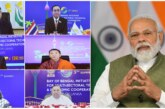Internal dynamics of group pressures in a coalition government have the potential of torpedoing the entire coalition edifice by announcing its withdrawal of support on the pretext of an issue or differences on policy matters. The arithmetic of numbers plays significant role in a democratic polity endowed with multiple party system as in India where no single national party has been in a position to stake a claim to form a government of its own at the Centre for about past two decades.
Be it the Congress Party or Bharatiya Janata Party (BJP) or the Left parties’ alliance led by CPI(M), all have been forced by the circumstances to forge alliances with powerful regional parties. Congress which initially was reluctant to share the political form regional parties in a coalition government had to shed its inhibitions and formed coalition governments at the state level before experimenting it at the Centre in May 2004 in the form of United Progressive Alliance (UPA). However, the BJP has been a forerunner in this regard and it has been part of the National Democratic Alliance (NDA), particularly since 1998.
Having completed four years in office in May 2008, the Congress-led UPA government celebrated the occasion in low tone in view of forthcoming elections to the State Assemblies and the general elections due in 2009. Speaking on the occasion in New Delhi on 21 May 2008, stated that four years ago the people of India wanted a Government that would be a unifying expression of the collective will of all the people of India. They sought the politics of inclusion and the economics of inclusiveness. They wanted a Government that every Indian, irrespective of region, language, caste, community or creed, could say here is ‘Our Government’, and claimed that the UPA government represented the aspirations of the people. However, Prime Minister’s claim that in these past four years, UPA Government has sincerely sought to implement the National Common Minimum Programme, is subject to debate.
The UPA government has introduced a novel practice for the first time in the history of governance in India by coming forward every year to present a Report to the People, placing on record what it had tried to do while in office. This annual Report of the UPA Government has reportedly set a new standard for accountability and transparency in governance. These reports also show that the UPA Government has so far been able to implement substantially the commitments made to the people in the NCMP.
The UPA government claims to have put in place an ‘architecture for inclusive growth’ by launching various programmes, viz, the National Rural Employment Guarantee Programme, the National Rural Health Mission, the Jawaharlal Nehru National Urban Renewal Mission, Bharat Nirman, the expanded Sarva Siksha Abhiyan and the Mid-Day Meal Programme, the Food Security Mission and the Rashtriya Krishi Vikas Yojana, etc. However, the practical utility and actual benefits accruing to the common man as a result of these programmes is yet to be seen because one cannot go by the official jugglery of statistics to measure the quantum of success unless the same claims are supported by other independent sources.
Undoubtedly the UPA government has put in place legislation to protect the livelihoods and land rights of tribal families living in forest areas. The Plan also seeks to ensure more regionally balanced development, with a special focus on the accelerated development of backward districts. Development of minority concentrated regions is getting due attention and importance. Special emphasis is being placed on the welfare, health, education, personal and economic security and empowerment of women and the girl child. It has made determined efforts to confront the challenge of child malnutrition and ensuring child rights. The ICDS and the mid-day meal program have been vastly expanded. However, these are the tall claims of the UPA placed at the Centre and what about the benefits of these plans trickling down to the last person in the row?
The latest UPA Annual Report claims that the Government has accorded high priority to the revitalization of agriculture, the empowerment of farmers and the modernization of the rural economy. It has also listed several initiatives taken to reverse the decade long neglect of agriculture since the mid-1990s. The Report claims that measures like improvement in the terms of trade for farmers, increase in the minimum support prices payable for foodgrains, increased investment in irrigation, agricultural research and rural infrastructure, launching of the Rashtriya Krishi Vikas Yojana with an allocation of Rs. 25,000 crore for the 11th Five Year Plan, along with the National Food Security Mission and the Rs 60,000 crore farmers debt relief package announced by the Finance Minister in this year’s Union Budget, will facilitate a turnaround of country’s agricultural economy.
The UPA government has reportedly made ‘determined efforts’ to accelerate the pace of development while maintaining reasonable price stability. Control of inflation has been a priority concern. The UPA Government ensured that the rate of inflation was brought down from around 6% in 2003-2004 to a little over 3% in the years 2004-05 and 2005-06. An upward pressure on prices since 2007 has been wholly on account of the steep increase in global commodity prices, especially oil and food prices. It has also affected inflation expectations. However, some of these claims are belied by the steep rise in essential commodities due to government’s apathy.
The sharp increase in global oil prices, the price of steel and the price of food crops has impacted domestic economy. The Government has responded by taking several measures like imposing restrictions on commodity exports, reducing tariffs to encourage cheaper imports etc. Besides, the authorities have taken fiscal and monetary policy initiatives and, wherever needed, administrative measures are being taken to discourage speculation and hoarding. While supply side and demand side measures will have their salutary impact on the price level, a normal monsoon and public recognition of the Government’s determination to reverse the recent spurt in inflation should also help alter the state of expectations. So far, the reports of the Rabi crop are good and the predictions of a good monsoon give hope and confidence that the steps taken so far will enable the government to return to a regime of moderate inflation in shortly.
The national economy is on a growth trajectory which can keep it growing at 8-9% p.a. At this rate, the country will be able to rid itself of chronic poverty, ignorance and disease which has been the fate of millions of people for centuries. There has been an increase in public investment in social welfare programmes, in education, in health care, in irrigation and agricultural research, in infrastructure, including rural infrastructure.
The 11th Five Year Plan has a special focus on education. India is a nation of young people. The initiatives taken in the field of education at all levels are expected to unleash the creative potential of the people, particularly young people. Investment in education has been increased with the twin objectives of widening access to education and promoting excellence. Special emphasis is being laid on the education of scheduled castes, scheduled tribes, other backward classes, minority communities and women.
The National Rural Employment Guarantee Programme has been universalized by covering all rural districts and the Government hopes that this historic programme will make a major contribution to softening the harsh edges of extreme poverty in rural India. However, much depends on the effective and transparent implementation of the NREGA by all State Governments.
The Annual Report claims that the UPA Government has worked hard to make growth process socially inclusive and regionally balanced. The North Eastern region, Jammu & Kashmir and other backward regions have received special attention, and will continue to do so. Taking the benefits of development to such areas is also the key to overcoming some of the challenges to internal security being faced by the country. The Government has also reiterated its firm resolve to strengthen Panchayati Raj institutions as a means of promoting accountability, decentralization and equitable development.
The menace of terrorism has been haunting the country for over two decades now. Terrorist and other subversive elements have continued to cause concern on the internal security front. Their aim is to spread disaffection and distrust among the people. Undoubtedly, the people of India will never allow these element them to succeed, standing as one and united in the great diversity. The report claims that the UPA Government has taken firm measures to improve the overall internal security situation and it will remain ever vigilant against any threats to the unity and integrity of India. The Government affirms that it will not hesitate to take resolute and firm action against such forces wherever necessary and will work with state governments to counter these threats.
The UPA Government’s claim that it has raised the global standing of India in these past four years can raise some eyebrows. India’s rising status in the comity of nations cannot solely be attributed to the policies of UPA. The pace of progress recorded by India has been a continuous process since the early 1990s and no single party can take credit for that. The world looks at India – and the enterprising people of India – with respect and admiration. Pace of development set in motion has continued unabated resulting in fruitful outcome in different fronts. Foreign trade, BPO, IT and innovations in technology are the areas which have done pride to the nation.
India’s greatness and admiration and respect it has come to command at the regional and global level is the product of collective actions of the people of the country and not the byproduct of efforts of political parties which are always eager to make political capital out of the situation to reap electoral dividends. Some of the positive achievements during the past years of the UPA reign can be attributed to the policies of the UPA government but it cannot take credit for everything.
BJP has ridiculed the UPA Government on completion of four years in office by bringing out a parallel ‘list of achievements’ of the Congress-led coalition which included ‘betrayal’ of the common man. The party listed the ‘achievements’ of the Government as ‘bartering’ of national security for votes, ‘imperiling’ food and economic security, ‘devaluing’ the office of the Prime Minister and other institutions and ‘sanctifying’ corruption.
BJP spokesperson Ravi Shankar Prasad said in New Delhi on 21 May 2008 that the stark truth about four years of the UPA government was its failure on all fronts, compounded by its betrayal of the common man in whose name the Congress had sought votes. In a sarcastic remark, Prasad said while ministers and leaders of the UPA attend the grand dinner, crores of ordinary Indians will be eating less than their normal meagre intake because skyrocketing prices have eaten into their per capita food consumption. The UPA Government’s failure to check spiralling inflation, which is robbing the paltry earnings of the common man, has imperiled their economic and food security.
This is not surprising, for the UPA is under the storm because of spiralling inflation which has touched the 7.8 per cent mark and poses the biggest challenge to the government. The BJP is sharpening its knives and attacked UPA for its ‘unkept promises’.
On the plus side, the Congress has run a stable coalition at the Centre for four years, managing the division between political power represented by Sonia Gandhi and a government headed by Manmohan Singh. The growth story has gone on for four continuous years; foreign exchange reserves stand at over $300 billion, which would have been inconceivable in 1991.
For all the shortcomings in implementation, this government will be remembered for enacting the National Rural Employment Guarantee Scheme and its extension to the whole country, and the path-breaking Right to Information Act which will increasingly be an empowering tool for the citizen. The Domestic Violence Bill will give succour to battered women.
The Women’s Reservation Bill was tabled in the Rajya Sabha on the last day of the Budget session. Nowhere near passage, given the resistance from the OBCs in every party, the government will have to create a political consensus on it de novo, if it is serious about reservation for women in legislatures. The government tried to correct its pro-rich image by going in for a Rs 60,000 crore loan waiver for farmers, though inflation wiped off its magic within weeks.
The singular failure of the government has been on the agriculture front, which has recorded only 2 per cent growth but 60 per cent of the population depends on it for its livelihood. Suicides by farmers continue, wheat was imported at double the prices paid to our farmers, the per capita intake of food dropped by around 10 per cent between 2002-06. This government, has talked about ‘aam admi’ but, like its predecessor, pursued polices which have helped only those who are rolling in opulence.
According to one of its reports, 77 per cent of Indians spend less than Rs 20 a day and yet India has the second largest number of billionaires today. India is surging ahead but ‘Bharat’ is lagging way behind. It makes for heightened social conflict, which we are witnessing in the form of agitations against SEZs or against prices. There is a widening disconnect between the rulers and the people they claim to represent and it manifests itself at election time. That is why parties are caught by surprise at electoral outcomes.
At the end of four years, the Congress is increasingly buffeted around by its allies, and the alliance is fraying at the edges. The more the Congress gives into the demands of its allies, the more it is pushed around. Union Shipping Minister T R Baalu openly defended his act of seeking special favours for his son, dragging the Prime Minister’s Office in an unseemly controversy, and the Budget session of Parliament had to be curtailed.
The Supreme Court’s verdict reinstating Dr P Venugopal as the director of the prestigious AIIMS after a prolonged spat with Union Health Minister Anbumani Ramdoss, came as a slap in the face of the government which had enacted a special law to show Venugopal the door under pressure from its junior southern ally.
West Bengal Chief Minister Buddhadeb Bhattacharya described Manmohan Singh as a ‘failed prime minister’, even as the PM described Buddhadeb as the best chief minister in the country.
Even the Rashtriya Janata Dal, which has been the Congress’ oldest and staunchest ally, was talking about withdrawing support to the government if it went ahead with the Women’s Reservation Bill, even though Lalu Prasad Yadav was party to the Cabinet decision to table it in the Upper House.
This is the tip of the iceberg. In a coalition era, every government has to contend with compulsions and maverick leaders. The UPA has failed to draw a `Laxman rekha’ beyond which no party should be allowed to push the government.
A major failure of the government and the ruling Congress is their inability to encash their achievements. There has been little sign of street campaigns to take these to the people. The Congress has shown no inclination or will for drum beating. The sniping by a senior Congress leader like Arjun Singh shows a weakening of the leadership’s authority.
It goes without saying that inflation will be the UPA’s Achilles heel. Onion prices had devoured Congress state governments in the Hindi states in the winter of 2003. Experts may discuss the rising prices of foodstuffs or of oil worldwide, but that does not mitigate the suffering of the common man who casts the vote.
Unlike 2004 when Sonia Gandhi took things into her hands and hit the road and stitched up alliances, there is a lack of grip this time, as if things are on auto pilot. Cabinet meetings get over in minutes. People are glibly talking of a third front government in 2009 supported by the Congress.
Some see a method in this madness. The Congress, they say, is not exhibiting a killer instinct because it realizes that the mandate in 2009 is likely to be more fractured than it was in 2004, that Uttar Pradesh Chief Minister Mayawati will be a player and may give whoever comes to power a real run around and that whichever government is cobbled together may not last long. And it is only after that, that the Congress’ chance will come.
While the explanation seems farfetched, for no political party can afford to think like that, the situation is clearly one of drift, as if no one is in control. There is disappointment with the government and a growing restiveness amongst farmers, workers, and the middle classes. Barring Haryana, the Congress has lost successive elections in the last four years — Punjab, Uttarakhand, Himachal Pradesh, UP, Gujarat — which has done nothing for its morale and it now it has lost Karnataka as well.
Since its formation, the UPA has been haunted by theory of numbers, specifically at this juncture when the Left Parties are bent upon pressurizing the Manmohan Singh government not to ratify the Indo-US civil nuclear signed in July 2005. the promise of support made by Samajwadi Party may bail out the UPA temporarily but it can also emerge another irritant for the smooth functioning of the government by demanding bigger share than it deserves, particularly with regard to Congress moves in UP.
However, for the very survival of the UPA till the elections to next Lok Sabha are announced, the Congress will have to buckle under pressure to concede even undeserving demands or face the ouster from office. The BJP-led NDA is sanguine about returning to power.
By Dr. Arvind Kumar, President, India Water Foundation



